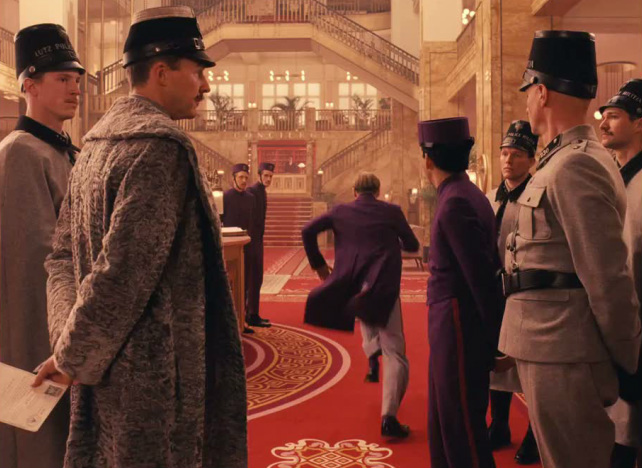For the screening assignment, the film that I picked to watch and analyze from the Browne Pop Culture Library was The Grand Budapest Hotel (Anderson, 2014). I highly enjoy the works of Wes Anderson and particularly love this film because of the visual elements, dialogue, and characters. In Anderson’s film, there are many simple yet effective shots that make this movie very visually pleasing like symmetry, changing ratios, different depths, and tracking shots.
Wes Anderson is a sucker for symmetry in his films so it wasn’t surprising that it was incorporated in The Grande Budapest Hotel. When he uses symmetry, there is no doubt who or what he wants the main focus to be on because it will be smack dab in the middle fo the screen and brought forward.

This film is very unique because it uses different aspect ratios to tell the different time periods that take place in the movie. For example, when the story is being told in the 1930s the ratio is 1.37:1, the 1960s part of the film is shown in 2.40:1, and the 1980s aspect ratio is 1.85:1. The reasoning behind this is because whenever those time periods were, the aspect ratio that I named was commonly used in films at that time. To me, that is absolutely genius and I noticed the change in aspect ratio but didn’t know why so when I found that out I was amazed at the detail put into the film.
![]()
In The Grand Budapest Hotel, there were many different depths to the film that you see the whole scene.It would make the film almost more funny at times because it was shot this way rather than just following the actor’s faces and cutting between them when they talk. For example, when the police came to the Grand Budapest Hotel and they are in the lobby. The whole scene includes the stairs in the very background, the lobby in the middle and the police in the front. Gustave and Zero (two main characters) come down the stairs and while they are walking towards the police, the chief looks away from them towards the camera and seems like he is trying to build the courage up for what he is about to say since Gustave is a good friend of his. Before Gustave could can say anything the chief tells Gustave that he is under arrest for the murder of Madame Soline (friend of Gustave) and Gustave says “she’s been murdered… and you think I did it”, then quickly runs for the stairs while Zero is following him, the scene is still filming in the same position as you see Gustave running up the stairs in the distance and the police following him while some stay behind in the foreground while looking confused.

In the film, there are many tracking shots that really add to the aesthetic of it. For example, when Zero is getting interviewed by Gustave, many different characters come in and out of the scene and is beautifully timed with the dialogue and where the camera/characters are going. This adds almost a chaotic touch to the scene because of everything that is going on and shows that being a busboy would be chaotic like that with everyone always wanting something but also Zero proving to Gustave that he can keep up while answering his questions.

Overall The Grand Budapest Hotel is one of my favorite films to this day because of the amazing detail put into the film. The film itself has many aspects that are pleasing to the eyes, ears, and heart.